Cambodian Chicken Red Curry, known as Somlar Kari Saek Mouan or sometimes Khmer Red Curry, is a rich, flavorful curry made with coconut milk, chicken, eggplant, green beans, potatoes, sweet potatoes, and a wonderful red curry paste called kroeung. It's similar to Thai red curry, but not as spicy.
We love to travel and always come home inspired by new dishes that we like to attempt to recreate. Some other recipes inspired by our travels include Thai Coconut Mango Sticky Rice, Baked Greek Feta Fries, and Authentic French Fruit Tart.
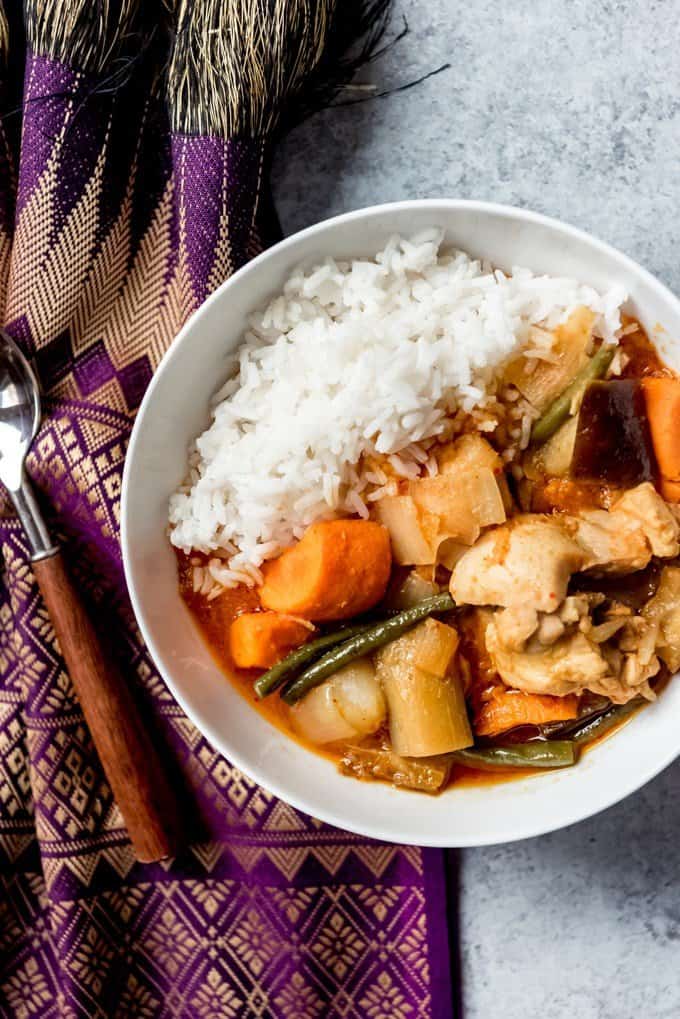
When our girls were 4 and 1 ½, we took them to Thailand and Cambodia for a couple of weeks. It was the first time we had ever traveled with them out of the country and they did amazing.
It was an epic, unforgettable trip where we explored crumbling temple ruins only partly reclaimed from jungles, fed, bathed, and rode elephants through the mountains of Thailand, and island hopped on a longtail boat in the Andaman Sea. We will never forget those experiences and adventures with our girls while they were so young and hope to take them back again someday.


One of the foods we enjoyed while we were in Cambodia was this amazing chicken red curry that we ate for lunch after spending a morning exploring the haunting and beautiful Angkor Wat.
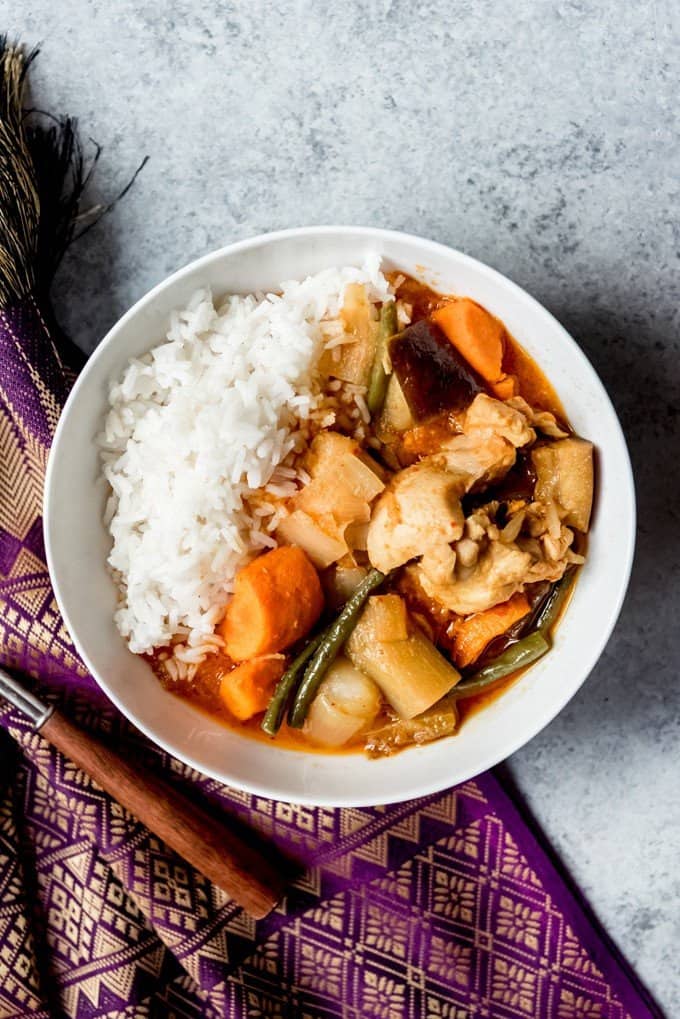
Cambodian food isn't nearly as well known as Thai food. It seems like there are Thai restaurants all over the place, but I don't know that I have ever seen a Cambodian restaurant.
So I was excited when I was challenged to recreate a traditional Cambodian dish as part of this month's Eat the World Challenge hosted by Culture Eatz.
I researched like crazy to try and figure out just how to make an authentic Khmer red curry at home and still be able to share a recipe with you that wouldn't be out of reach for the average American home cook. Fortunately, I had some experience with some of the unusual ingredients thanks to a couple of cooking classes I took while in Thailand.
Similar to Thai cooking, Cambodian cuisine typically has a balance of salty, sour, sweet and bitter flavors in every meal. Cambodia and Thailand have a complicated history with borders being fought over for centuries. Because of that, their cuisines bear a lot of similarities, with strong Chinese and Vietnamese influences as well given their proximity to southern China and Vietnam, as well as French influences because of their presence in much of Southeast Asia in the 1800's.
The biggest difference that I notice, though, is that Cambodian dishes tend to be far less spicy than their Thai counterparts. Which made it a wonderful introduction for our girls, who loved the rich, flavorful curries and noodles and rice dishes that weren't too spicy at all.
Traditionally, Cambodian chicken red curry is served with French bread, but you can also serve it with noodles or rice, like we did here. It's a thin curry, closer to a soup than anything else, although it's loaded with meat, potatoes, and veggies that area chopped into large bites and cooked in the savory broth. The French bread is used for sopping up juices.
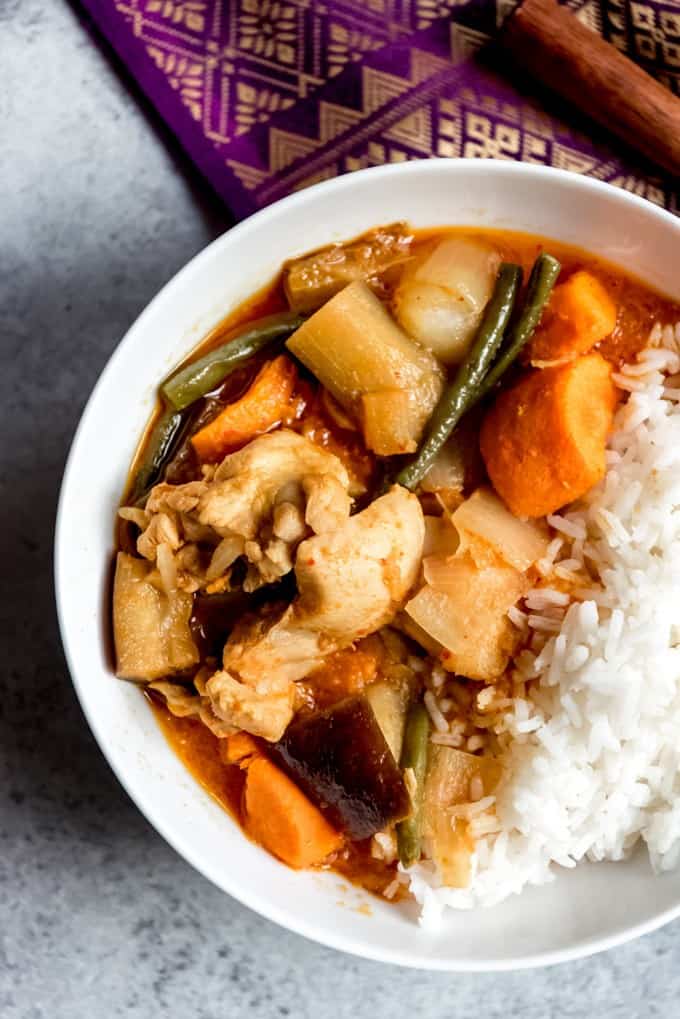
Ingredients in Cambodian Chicken Red Curry
I know that this list might seem overwhelming, especially since some of the ingredients are foreign to most American home cooks. But most of them are readily available at your local grocery store, so please don't be too intimidated!
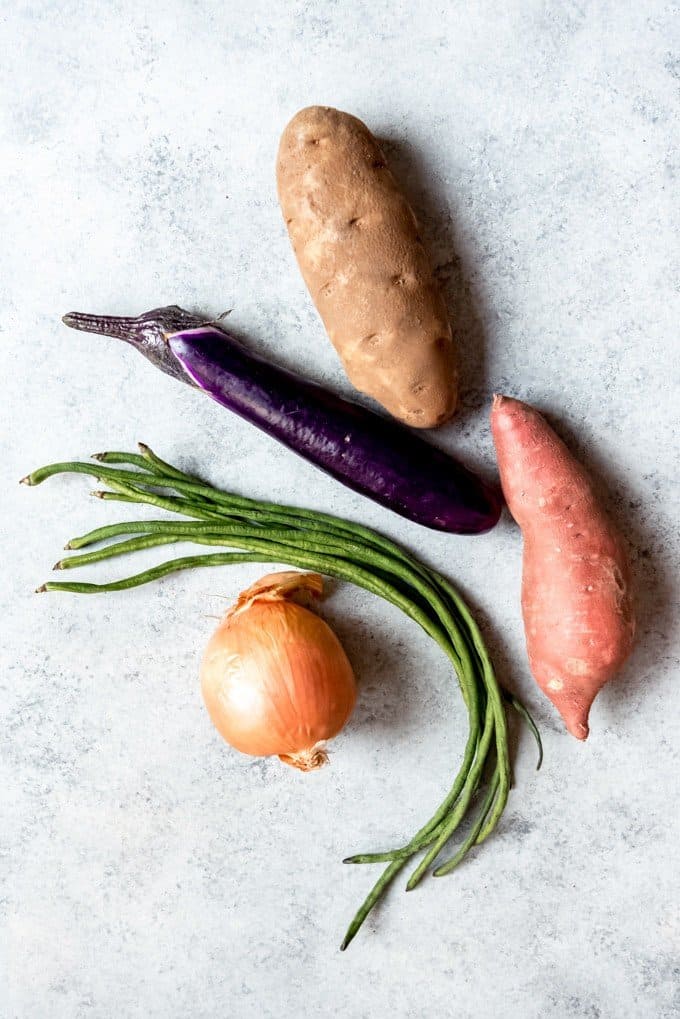
Here are the easy ones that you shouldn't have much difficulty finding on your local store's shelves or in the produce department.
- lemongrass (these long and skinny stalks are always available in the produce section)
- garlic
- shallots
- ginger root
- kosher salt
- Thai red chili (also known as a bird's eye chili pepper, they are really small red or green peppers, also in the produce section with all the other peppers)
- large dried red peppers (I find these in the Hispanic or Mexican section at the grocery store in big bags. Sometimes they are labeled as California Peppers where I am at.)
- boneless, skinless chicken thighs
- oil
- yellow onion
- eggplant (also known as aubergine - I used the narrow Chinese eggplant instead of the fat, chunky ones)
- russet potato
- sweet potato
- fish sauce (in the aisle with the Asian products, usually near the soy sauce)
- coconut milk (get the full fat kind)
- water
This is a Thai red chili pepper, sometimes called a bird's eye chili pepper, just in case you aren't sure what to look for at the store.
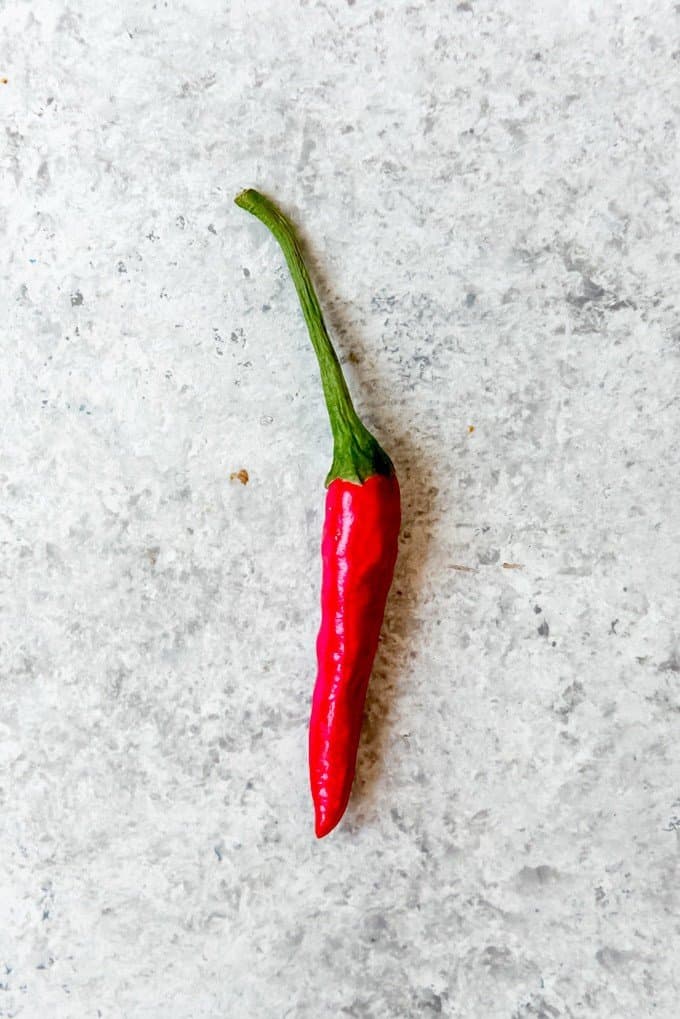
Here are the more exotic ingredients that took more effort to track down.
- kaffir lime leaves (known for their citrus and pine scent, kaffir lime leaves are used in many, many Cambodian and Thai dishes. But even though it's not a perfect substitute, you can use regular lime zest for the kaffir lime leaves, which are almost impossible to obtain unless you order them online. 1 ½ teaspoons of lime zest is close enough to the flavor you would get from 1 kaffir lime leaf. Supposedly you can sometimes find kaffir lime leaves dried or frozen at Asian food stores, but I live pretty close to San Francisco and have access to quite a lot of Asian food stores and couldn't find any anywhere. I honestly don't notice a difference between the two, although kaffir lime leaves are very traditional for both Thai and Cambodian cooking.)
- galangal root (sometimes just called galanga, at least at my local Asian market. This was an easy find, although you could also order it online.)
- shrimp paste (another easy find, available at any Asian market or available online. Although to be honest, I did have to ask a store clerk to point me to the right aisle.)
- palm sugar (not overly sweet, a slightly less amount of brown sugar makes a decent substitute)
- yardlong beans (also known as snake beans or a bunch of other names, but could be substituted with French green beans without any noticeable difference)
- fresh turmeric root (fresh turmeric root was on the shelf in our produce aisle at Safeway so I used it, but you can easily sub ground turmeric instead. 1 teaspoon of dried turmeric is equal to 1 tablespoon of fresh turmeric, which is what you get from grating a 2-inch piece of turmeric root. Along with terribly stained yellow fingers if you don't wear gloves. It took 2 days of scrubbing for the yellow to go away!)
It's quite a list, I know, but you could order all of the difficult to find ingredients online and have them shipped to you if you want to be totally authentic, or use the readily available substitutions instead and still get a red curry that tastes incredible and you would probably hardly notice a difference between the two.
This is galangal root. It looks really similar to ginger. Just peel the outer skin and slice or grate the inside part just as you would with ginger.
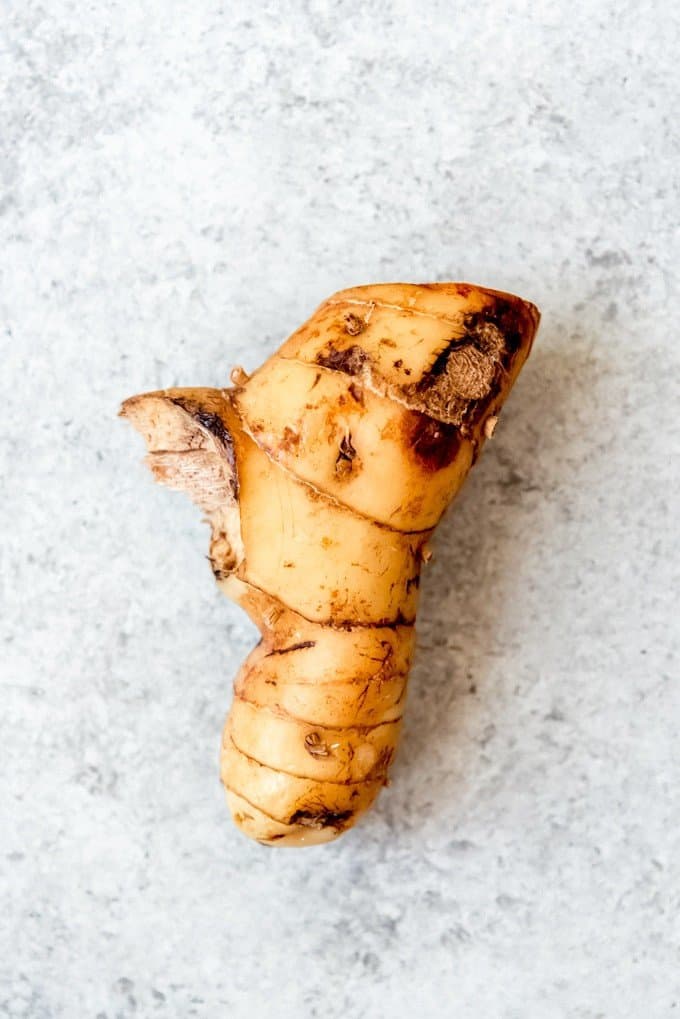
Here is turmeric root. I fully planned to just use ground turmeric, but then happened to spot this at my regular grocery store so I went ahead and got it.
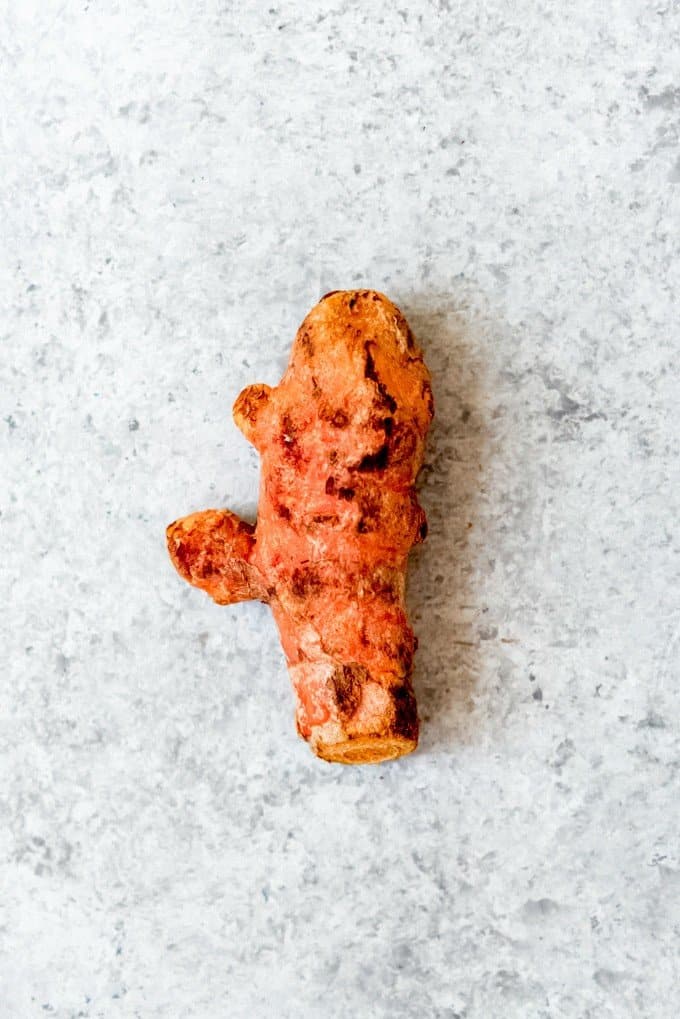
Shrimp paste has a really strong smell but it adds important flavor to this dish. I'm still trying to figure out what to do with the rest of the jar, but I'm sure I will find something.
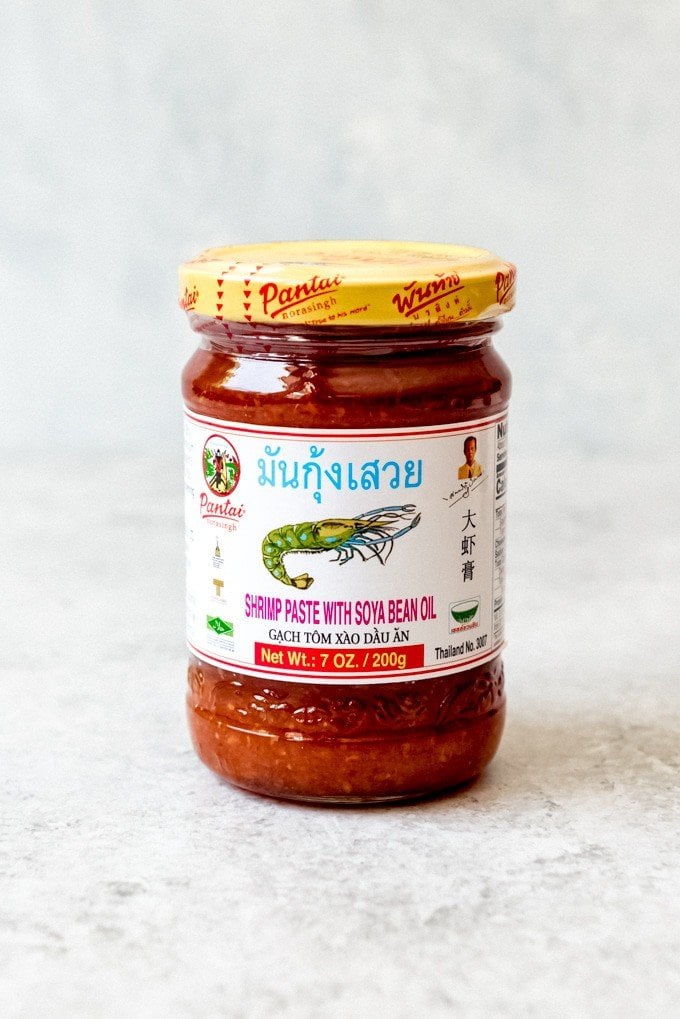
Kroeung Paste
Unlike Thai red curry paste, which you can buy in little jars at the grocery store for making Thai red curry, the only way to get Cambodian red curry paste, known as kroeung paste, is to make your own.
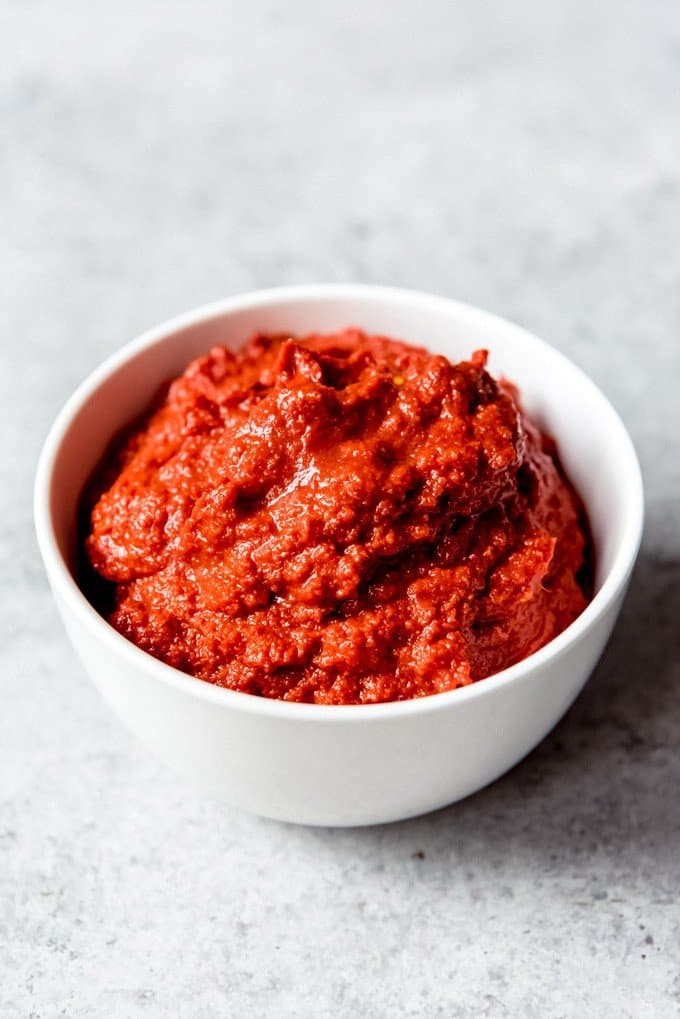
Which, I'll admit, was intimidating at first until I realized all I needed to do was blend everything in my Vitamix. It actually was a breeze once I had located all of my ingredients.
Kroeung paste is used to flavor lots of Cambodian dishes, including everything from curries to soups to stir-fries. There doesn't seem to be one set recipe for kroeung paste, with some Cambodian chefs preferring more lemongrass or turmeric and less galangal, or any other number of adjustments like increasing the heat with more chili peppers.
But traditionally, the paste is made using a mortar and pestle to pound the finely sliced ingredients into a paste. I started out that route, but gave up and just dumped everything in the blender instead. I try to be authentic, but I was also making this on a day when we had swim lessons and swim team practice that afternoon so I was also trying to be practical.

How to Make Cambodian Chicken Red Curry
I largely based my Cambodian red curry recipe on the wonderful recipes shared by 196 Flavors and this traditional Cambodian red curry video and this curry paste video from Dany Kao who shares her traditional Cambodian recipes on YouTube.
First, make the kroeung curry paste.
Combine the kroeung paste ingredients in a blender, adding the ¾ cup reserved water from soaking the dried red peppers as needed and blending until a smooth paste forms. It should be a deep red color. Store any leftover kroeung paste in the freezer until ready to use.
Next, make the curry.
In a large heavy bottomed dutch oven or pot, heat the oil over medium heat. Add the kroeung curry paste and stir for one minute.
Add the chicken and 1 cup of the coconut milk and stir to combine with the curry paste. Cook for 2 minutes to allow the flavors to develop.
Add the onion, beans, eggplant, and potatoes and stir to combine. Add the remaining coconut milk and water, along with the fish sauce, shrimp paste, palm sugar, and salt. Increase the heat to medium-high just until the liquid comes to a boil, then decrease to medium-low and simmer for 20-25 minutes, until the chicken is cooked through and the vegetables are soft.
Serve with french bread, rice, or noodles.
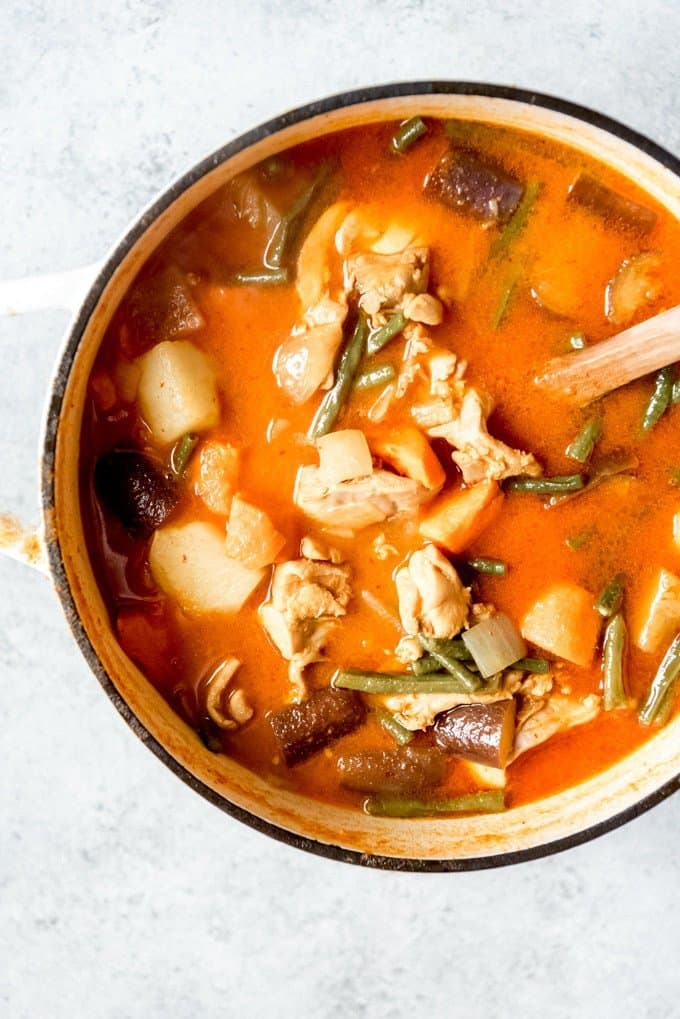

More Asian Recipes You Might Enjoy
- Beef with Broccoli
- Easy Chicken & Vegetable Stir-Fry
- Honey Walnut Shrimp
- Asian Slaw with Ginger Peanut Dressing
Did you make this recipe?
Let me know what you thought with a comment and rating below. You can also take a picture and tag me on Instagram @houseofnasheats or share it on the Pinterest pin so I can see.
Cambodian Chicken Red Curry
Ingredients
Red Kroeung Paste
- 2 lemongrass stalks, outer leaves discarded and tender insides roughly chopped
- 4 cloves garlic, minced
- 2 shallots, peeled and chopped
- 2 kaffir lime leaves, cut into thin strips (or the zest of two limes)
- 1 inch fresh ginger, peeled and chopped
- 1 Tablespoon fresh turmeric, peeled and grated or finely minced (or 1 teaspoons of ground turmeric powder)
- 2 inches galangal, peeled and grated or finely minced
- ¼ teaspoon Kosher salt
- 1 Thai chili pepper (aka bird's eye chili)
- 5 large dried red peppers, seeds and stems removed, rehydrated by soaking in hot water for 10 minutes (reserve ¾ cup of the water!)
Curry
- 3 Tablespoons vegetable oil
- 6-10 Tablespoons red kroeung paste, to taste
- 8 bone-in chicken thighs, each cut into 2 pieces
- 1 can coconut milk
- 1 large onion, roughly chopped
- 5-8 yardlong beans, cut into 2-inch pieces
- 1 small eggplant, also known as aubergine, cut into 2-inch pieces
- 1 large white potato, peeled, then cut into 2-inch pieces
- 1 medium sweet potato, peeled, then cut into 2-inch pieces
- 2-3 Tablespoons fish sauce
- 1 teaspoon shrimp paste
- 2 Tablespoons palm sugar
- 1 teaspoon Kosher salt
- 3-4 cups water
Instructions
Kroeung Paste
- Combine the kroeung paste ingredients in a blender, adding the ¾ cup reserved water from soaking the dried red peppers as needed and blending until a smooth paste forms. It should be a deep red color. Store any leftover kroeung paste in the freezer until ready to use.
Curry
- In a large heavy bottomed dutch oven or pot, heat the oil over medium heat. Add the kroeung curry paste and stir for one minute.
- Add the chicken and 1 cup of the coconut milk and stir to combine with the curry paste. Cook for 2 minutes to allow the flavors to develop.
- Add the onion, beans, eggplant, and potatoes and stir to combine.
- Add the remaining coconut milk and water, along with the fish sauce, shrimp paste, palm sugar, and salt. Increase the heat to medium-high just until the liquid comes to a boil, then decrease to medium-low and simmer for 20-25 minutes, until the chicken is cooked through and the vegetables are soft.
- Serve with french bread, rice, or noodles.

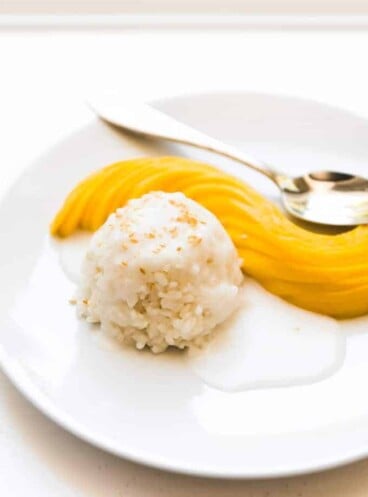
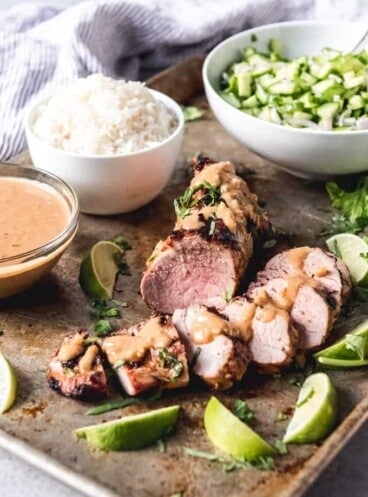
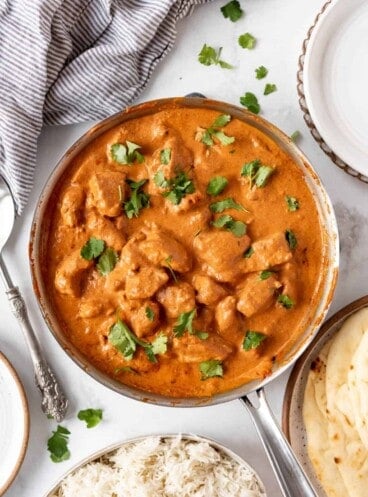
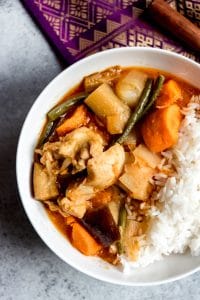
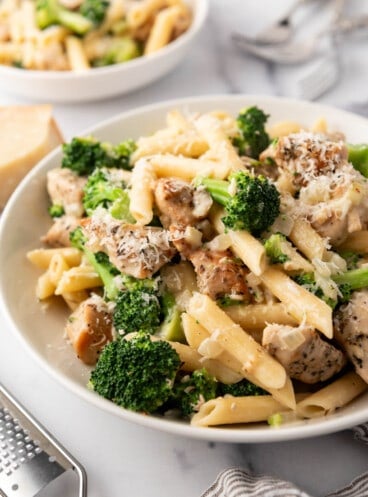
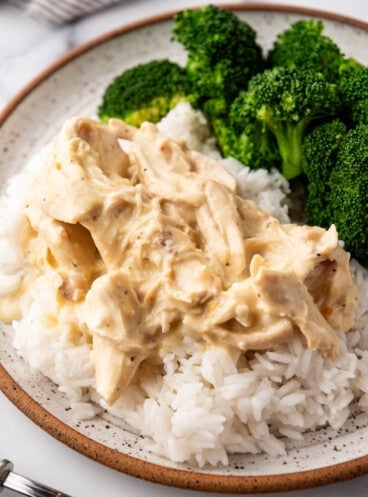

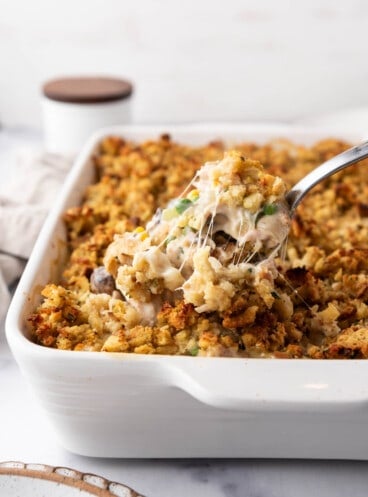

Thanks so much for sharing your trip with us. This stew sounds so delicious.
Mmm. I'm a wimp when it comes to fiery hot curries, so this one is right up my alley. I can see how making a batch of the paste and freezing it would be like having a stash of red gold in the freezer!
Looks so delicious!!!
This looks so full of flavor and so perfectly balanced. I know that my father in law will be super impressed with this when I make it for him!
What a beautiful recipe! It looks so flavorful. We haven't been to Cambodia or Thailand but would love to visit. I don't know if I would be brave enough to take our children when they were that young though.
I can almost smell the amazing aroma when this is cooking, what an amazing meal! And what a great experience for you and your family. I hope you do make it back to Cambodia for another adventure!
Oh my! What an incredible traveling experience and this recipe- WOW!! The flavors are absolutely amazing and I cannot wait to give this a try!
What a perfect bowl of comfort food! Even when it's hot outside, I am ready to dive my spoon into this!
You took cooking classes while in Thailand? How cool is that and you definitely nailed this dish. Pinning to make soon!
I love how you travel with your girls while they are young! My parents took us everywhere and I have such amazing memories from it. I make Thai curries all of the time but have a friend who cant do spicy so this sounds right up her alley. I think I have all the ingredients or know where to get them so when she comes next week Im going to try this!
This dish sounds amazing! The combination of flavors really steps this dinner recipe up.
I always love visiting your blog and hearing about your travels!! How fun to eat your way through this amazing world!
Please don’t take these comments personal because they’re not meant to be. Just a couple suggestions from someone that’s been cooking Asian food for many years. I’ve learned a lot over those years. I’ve also cooked professionally for close to 20 years & am obsessed with almost all the many varieties & ethnicities of southeast Asian cuisines. First I’d like to say that the kaffir lime leaves you said are almost impossible to find are actually quite easy to source & absolutely essential to replicating & being successful with the true flavor of these dishes. There is no substitute for them as they have an absolutely one of a kind taste, flavor & aroma to them. Lime zest isn’t an acceptable or appropriate substitute as it tastes nothing like the actual kaffir lime leaves themselves. You’d do better to just omit them altogether than use the zest from a regular common Persian lime. As I said before they are easy to find year around at Amazon, Importfood.com & TempleofThai.com. They are a hardy ingredient so they ship well, store well & for some time in the refrigerator & freeze exceptionally well also. Wrapped well I’ve kept them for as long as 2 years w/o losing much quality in flavor at all !!! The whole kaffir limes themselves are seasonal but are fairly easy to find as well from the mentioned websites stated earlier. They freeze great for sometime if wrapped properly, so buy a dozen & store in the freezer when you need the zest for making Thai curry pastes, etc. The other comment I have is about the shrimp paste you talked about in your recipe. The pic you have of the shrimp in soya bean oil is an incorrect product for making Thai curry pastes. What you’re wanting is a product actually called shrimp paste or as Thai people call it gkapi. It’s an extremely pungent ingredient but one that is just as essential as any other ingredient called for in a curry paste. Roasting & slightly charring it around the edges mellows it out a lot & makes it much easier to smell & deal with in the kitchen. The product you have in the pic is an item I’m very familiar with & use it for Thai fried rice, stir fries & a few other dishes as well. By the way, Pantainorasingh is a good producer of gkapi/ shrimp paste and they produce the product in Thailand. I hope you don’t take my suggestions personal. It was just meant to be informative & to let you know & your online followers that you can produce dishes that taste precisely like the real thing from our own kitchens as well with not much extra effort at all. I learned a lot of what I know from tireless experimentation, lots of reading & also spending a lot of time talking to people in Asian markets that grew up eating & cooking these wonderful foods & recipes. Good luck to you & just one more word of advice. Find yourself those kaffir lime leaves. They’re my most cherished & favorite single ingredient of all time. Each time I smell them it brings a smile to my face & just for a split second, everything in the world seems right & without a worry whatsoever. Good luck & God bless!
Thank you for your thorough and thoughtful comment! I really appreciate that you took the time to share your expertise with me and other readers! I have found kaffir lime leaves since posting this and you are right - they are wonderful!
Hi! I’m Cambodian born in Thailand but grew up here in Long Beach California where there’s so many Cambodians and even Cambodian restaurants. If you’re ever out here, you’ll be able to visit many Cambodian restaurants. We even have a street dedicated to Cambodians and the area is call Cambodia Town. Your curry looks so good! The ingredient is on point! Thanks for sharing this recipe and your adventure in Cambodia:).
Thank you for your vote of confidence in this recipe! I would love to try some of the Cambodian restaurants down in Long Beach! I had no idea there was an area there known as Cambodia Town.
As a Cambodian-American, this is as authentic you can get. Well done on your research! I admit I rolled my eyes when I first saw this in my news feed and was curious to see if you even mentioned the kreoung. But after reading, my respect grew. Cheers!
Thank you so much for your comment! I loved this dish so much when we were in Cambodia that I wanted to be as thorough in my research and get it as authentic as I possibly could to what I remembered.
Thai and Cambodian cuisine also have Malay cuisine influences...note that equivalent of kroeung is the the Malay rempah which is basis for many Malay dishes
I did not know about Malay rempah! Thank you for introducing me because I would love to learn more about Malay cuisine!
Cambodian cuisine is the oldest among the three and although there are overlapping ingredients due to being in the same region, each region's paste does have variations. Cambodian kreung is based on an earthy, lemongrass taste while rempah uses shrimp paste and does not include shallots, kaffir lime, galangal or various root vegetables. Thai curry or lemongrass paste leaves out certain root vegetables and also uses more chili.
Interesting recipe! I just have one extra comment to add, that no one else has mentioned 🙂
In Khmer cooking (my parents grew up in Cambodia) one of the key differences between traditional Khmer and Thai cooking is that Fish Paste/Gkapi is used for Thai cooking while traditional Khmer dishes used Prahok, a fermented fish paste, most often made from Mudfish!
Now in today's culinary world, a lot of youtubers/internet recipes may call for Gkapi in Khmer recipes, but this would not have been true over 40 years ago when my mother was growing up. So if you ever wanted to attempt an even more authentic recipe, I thought this fact might be helpful 🙂
I do commend you on trying your best to make an accessible recipe! It makes me really happy to see other people embrace Khmer food as it's not as well known in the western world.
Thank you so much for sharing your experience and insight, Angela! I'm so glad to know that about gkapi and prahok! I had never seen this before but I will have pay better attention to this detail the next time I make this and see if I can hunt the prahok down to use. We absolutely fell in love with Khmer food while we were in Cambodia and hope to return someday!
Please help... I'm in Australia and can't find dried red peppers except for powdered red peppers... My other options are fresh peppers or char grilled marinated peppers...
Please suggest your best substitute idea... Thanks
Also, the amount I should use to substitute
Thanks again
Hmm, that's a tricky question. I guess I would try using fresh red peppers, probably 3 of them, and see how well that tastes.
What kind of dried red peppers?
I find these in the Hispanic or Mexican section at the grocery store in big bags. Sometimes they are labeled as California Peppers where I am at. I hope that helps!
Thank you. Are Cali peppers small and hot? I tried this recipe with dried ancho peppers and those were definitely not the right kind for Cambodian curry.
I used dried Anaheim chili peppers, which are sometimes called California chili peppers. They are very mild and slightly sweet.
What variety of dried red pepper does this refer to, for the kroeung paste? I want to give this a try and I want to make sure I've got it right. Thanks!
I used dried anaheim chilies. They might not be the most accurate, but I felt like they worked well and were the most readily available option I had that tasted close to what I remembered from my time in Cambodia.